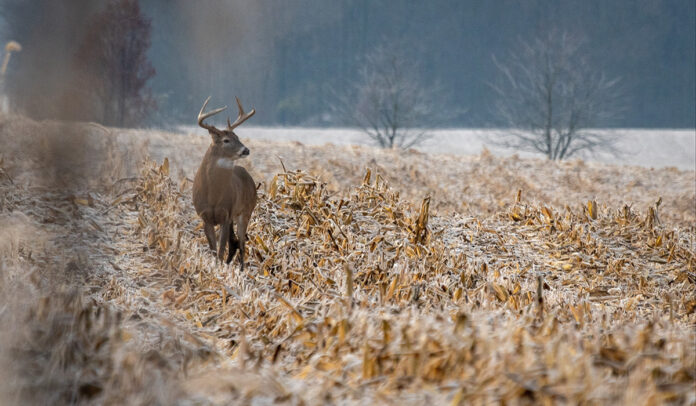There have been many evenings this winter where my headlights have revealed upwards of 30 deer in the hay field behind my house. Combining an overpopulated herd of deer and a mild winter with little snow cover leads to many visitors to the all-you-can-eat hay buffet.
At first, I wasn’t too concerned about deer in the hay; after all, they aren’t pesky raccoons in my sweet corn or the disreputable groundhog in a soybean field. As I thought about it more, I started to wonder if having a herd of deer congregating in a hay field for many months of the year, not just winter, was having a negative effect on hay yield.
What do deer eat?
Whitetail deer have access to a variety of food sources in the wild. According to the National Deer Association, deer mainly consume their fuel by browsing leaves, buds, and twigs from new growth on woody perennials. They also found that perennial grasses are not a favorite meal, except for late winter and early spring when the grasses are the only green material available. Those are both good things when it comes to deer damage in hay fields.
Unfortunately, after browse, the next highest items on a deer’s diet are forbs. Forbs are herbaceous, broad-leaf plants that include many plants found in the wild, as well as plants like soybeans, alfalfa, clover and other legumes. This means that deer are likely going for broad-leaf plants in our forages more than grasses, and on top of that, they are targeting them throughout the year.
The numbers
The conclusion that deer prefer legumes is backed up by research. According to a study done by Penn State, they found that deer sought out the alfalfa in alfalfa-grass mixtures. They also found on average that deer reduced yields of their pure alfalfa fields by 54%, while they only saw a 7% decrease in pure orchard grass stands. When comparing orchard grass to timothy, the study found that deer preferred the latter.
Another study done in Quebec, Canada, found that deer damage in hay fields caused an annual loss of 12% to 14% of yield. Thankfully, they found that though yield decreased, the hay quality did not. The study also noted that much of the damage was caused in early spring when the alfalfa was just starting to grow.
The research shows that deer are impacting yields and that they target alfalfa and other legumes. This is troubling because those legumes are often what bring a lot of value to our hay and pastures. While there have only been a handful of these studies done, and the results will vary depending on the local deer population, it is fair to say that deer can significantly impact our forages.
What to do
So what is to be done about the deer? Are they just a cost of doing business — a “wildlife tax” that is paid each year?
Even though damage can be high, an 8-foot-tall fence around all your hay fields won’t make financial sense. That means it is safe to say that forage producers will have to live with some level of deer damage. That being said, there are a few actions that can be taken to reduce the yield loss.
One way of reducing yield loss is to plant a mixture of grasses and legumes. Legume only stands seem to fair the worst in the studies. The Penn State study I mentioned earlier states that the highest economic return was found in mixes that had over 50% timothy or 25% to 75% orchard grass in them. Because we know deer don’t particularly like perennial grasses, we can use this to our advantage.
Another option would be to try and suppress the deer population. If you are in an area with high populations, this could be beneficial to the entire ecosystem, not just your hay crop.
Allow deer hunting on your property, if you don’t already hunt yourself, and apply for Deer Damage Permits with your state’s wildlife department. While not a perfect solution, hunting is often seen as the most effective way to cull growing deer numbers.
Finally, field location can play a role in the amount of deer damage that occurs. A field that is surrounded by woods, hidden from a road, or far away from human activity, will likely see more deer damage. Take this into account when renting or buying new fields, or when making cropping decisions.
Final thoughts
About 20 years ago, the National Agricultural Statistics Service shared a study that field crop losses from wildlife in the United States totaled $619 million (58% of those damages were due to deer). It is likely that number would be higher today, especially as we are seeing more deer pressure.
While wildlife damage is often thought to be in just corn and soybeans, it is important to consider the impact it has on our forages. While options are limited, I encourage you to try and protect your forage and reduce that damage. Next time I see a whitetail grazing behind my house from my truck, I think I’ll honk my horn.













